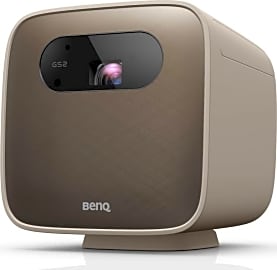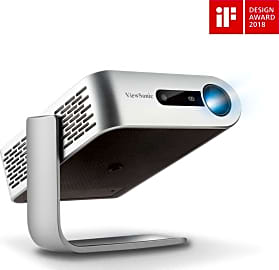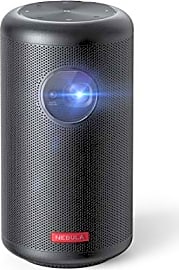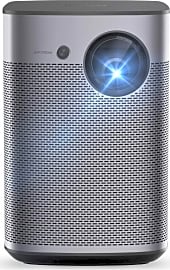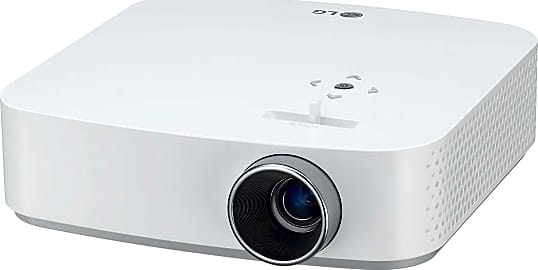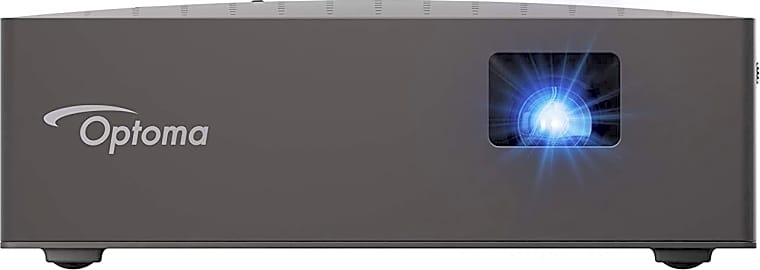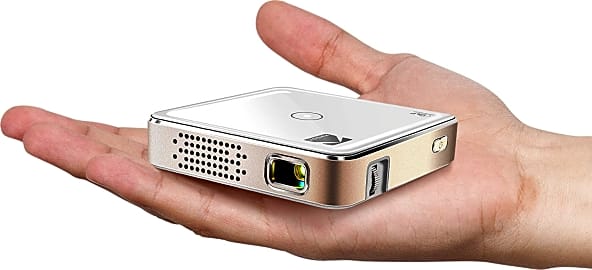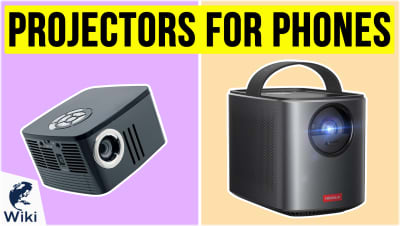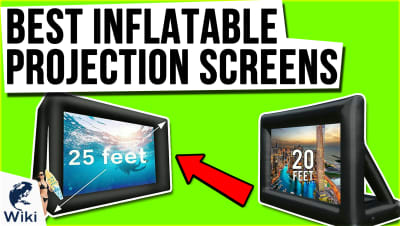The 10 Best Portable Projectors

This wiki has been updated 44 times since it was first published in February of 2015. If you like the idea of sharing videos with your friends on a screen bigger than your phone, or of watching movies while camping in the great outdoors, one of these mini pocket projectors may be just what you need. These compact devices allow you to set up your own theater anywhere you please, and many have built-in rechargeable batteries that will last for the length of most films. When users buy our independently chosen editorial selections, we may earn commissions to help fund the Wiki.
Editor's Notes
October 29, 2020:
As is to be expected with most electronics, we've seen quite a few new models of portable projectors come out in the past year, and so we updated this list considerably to better reflect all of these changes. We also decided to exclude any models that did not have a built-in battery, as there are now enough high-quality models on the market now to consider that a prerequisite to qualify as "portable". If you don't need something that can run on battery power, you may want to view or list of standard video projectors.
Picture quality is one of the main improvements you'll see throughout this list. More than half of these items are 1080p, with just the Anker Nebula Mars II Pro and Anker Nebula Capsule Max offering 720p and the Optoma LV130 only 480p. For cinephiles that really want a high-quality picture, the Xgimi Halo offers the brightest display, though if it's a bit too pricy for you, the LG CineBeam PF50KA and AAXA P7 both boast solid image specs as well. It should also be noted that, while the Kodak Ultra Mini does offer high definition, with a mere 60 lumen lamp, it's unlikely that you'll get a terribly clear image unless the room is very dark and/or the projector is quite close to the screen.
In terms of sound, the dual 10W speakers of the Anker Nebula Mars II Pro truly do set it apart from the others. The ViewSonic M1+ and Xgimi MoGo Pro are also great options, for those who don't want to connect an external speaker or headphones. The BenQ GS2 includes a 1/8" jack for headphones or an aux cable, so it should be easy to set up alternate sound, and a number of others allow you to connect speakers via bluetooth.
As with anything, be sure to do your research before finalizing any purchases to make sure that it has the correct ports and compatibility to fit your needs. No item on this list is perfect or ideal for all needs, so understand what types of devices you'd like to connect to yours, what your needs are in terms of battery life, and how much you're willing to spend, and use that information to narrow down these items. Once you've done that, you can pick out a screen and maybe am HDMI cable and you'll be ready to start your own movie nights.
November 11, 2019:
There are some impressive projectors on the market right now that are compact enough to lug around easily. For relatively affordable options, check out the ViewSonic M1+ and Artlii Mana, which perform well above their reasonable prices, while the Laser Beam Pro C200 is just a bit more costly and provides an especially clear image without the need for focus adjustment. The Aaxa P6 is another entry-level model worth looking at, as one of its few drawbacks is the lack of built-in streaming apps; a lot of users don't need or want all that extra software.
In the middle of the range there are some excellent options that put out actual HD pictures. The Anker Nebula Capsule Max and Anker Nebula Mars II Pro are two of the newest products from a very popular consumer electronics company founded by former Google engineer Steven Yang, and they're definitely two of the best. Where some cheaper projectors tend to fudge brightness and contrast numbers a little, Anker does a fantastic job of producing reliable and powerful electronics. We'd also strongly recommend the LG CineBeam PH550 and LG CineBeam PF50KA; the first is highly portable with a ton of convenient features while the second is a reasonably priced unit with a true Full HD output.
Then there are a couple high-end models worth considering if you have the budget for them. The Epson PowerLite 1795F uses high-end RGB LED technology to deliver about the best 1080p image you can find in such a small package, while the Aaxa 4K1 is one of the few to offer Ultra HD support at 60 hertz thanks to its use of HDMI 2.0.
Special Honors
Sony Full HD SXRD Home Cinema Projector If you reach the point where the portable projector just isn't meeting your needs anymore and decide to create your own home theater, this is a great place to start. With 1080p resolution, a lamp that is several times brighter than that of the average portable projector, and 3D compatibility, this offers great picture quality, even in rooms that aren't completely dark. The price may have some people balking, though it's hard to beat for the features it includes. sony.com
Through The Millions Of Tiny Looking Glasses
When you go to the movies and sit beneath the beam of a professional theatrical projector, you're subjecting yourself to the reflections of at least two million mirrors.
Reflected images have been with us since sentient beings have had eyes. All it takes is a little water and a little light, and you've got mirror advanced enough to lure young Narcissus to his watery grave.
The mirror itself is somewhat newer, though its presence in folklore and fairy tales speaks volumes of our reverence for its apparent magic. It is that very magic that a projector harnesses to send you the images you love to see.
When you go to the movies and sit beneath the beam of a professional theatrical projector, you're subjecting yourself to the reflections of at least two million mirrors. These mirrors are, of course, rather small, but they do the job of switching on and off behind dedicated color chips and reflecting a powerful source of light through the lens and onto the screen.
Portable projectors work on much the same principal, except their mirrors may not be as finely ground, nor their lenses as perfectly honed as the professional machines that come with enormous price tags.
There's also a resolution limitation here. More mirrors will get you higher resolutions, with about half as many mirrors needed as pixels in the original image. If you want a 4K image, you need about 2,073,600 mirrors, which are hard to fit in a portable projector. This is one of the reasons that most portable projectors limit you to a 1920x1080 resolution or less.
A Picture Quality Is Only Worth 1000 Words
If we were merely talking about projectors here, we could go on at length about the nuanced differences between laser projection and traditional DLP or LCD projection, but let's just say this: laser is technically superior, but not at these price points, where DLP and LCD are the champs.
We could also get into a whole world of features like upscaling, bulb life, color recreation, ease of installation, etc. But there is only one true feature that you must take into account before all others when considering a portable projector: portability.
Our top projectors do, but they are slightly larger than the most portable among the lot.
It seems silly to have to say so, but a solid third of the projectors on our list ought to have you tilting your head inquisitively at the notion that these particular models are actually that portable. They're certainly advertised as such, and compared to some of the behemoth projectors in the world they are, indeed, much more portable.
Still, I think a portable projector is only as good as how far away you can take it. That means the smaller the body and the longer the battery life, the better.
This, like most things technological, does come with a caveat. The absolute smallest projectors on our list do not have the best image quality. Our top projectors do, but they are slightly larger than the most portable among the lot. The best image quality is going to come to you from the projectors on our list who use the term 'portable' with a distinct sense of poetry.
If this is going to be your one and only projector, and you only need it to be portable enough to take across town without having to remove a portion of your ceiling, then you might be best served by a unit with great resolution and a bigger body. If you're trying to project educational videos onto cave walls in Altamira like some anachronistic social studies teacher, more portable might be best.
Projection From The Distant Past
The history of the projector is a history of the movies. It's a history rich with the buttery smell of fresh popcorn, the hush of a darkening theater, and the unveiling of hidden worlds to hungry, curious minds.
You can, if you so chose, reach back to the camera obscura of the 5th century BCE for its true origins in the writings of the Chinese philosopher Mozi. Aristotle wrote of it a hundred years later, and Leonardo DaVinci published what may be the most elucidating account of it in 1502.
Light comes in through the hole and hits a reflective surface, bouncing a portion of the scene outside the room onto a surface within.
Basically, a camera obscura is a large box, or even a room, with a tiny hole in it. Light comes in through the hole and hits a reflective surface, bouncing a portion of the scene outside the room onto a surface within. While the dimensions of projection have changed, we're still sending light through tiny spaces, bouncing it off of mirrors, and projecting it against a surface.
The projectors on our list, however, are movie projectors first and foremost. And movie projectors operate at a specific frame rate that satisfies the human visual system's expectation for natural movement while essentially showing you a sequence of still images. One of the reasons old silent films look strange is that they use higher frame rates, making everything seem like it's going a little too fast to be natural.
The earliest projectors in the era of the moving photographic image were hand-cranked, so the frame rate was inconsistent. Over time, the industry calibrated everything to work at the same frame rate, and the standard 24 frames per second of these and all other projectors was born.



